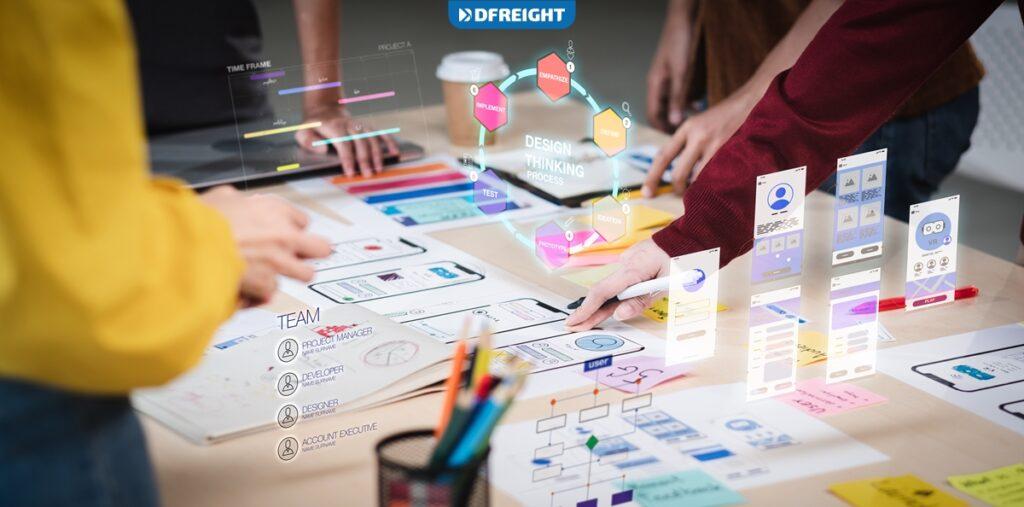Design thinking has been gaining popularity recently as a way to approach problem-solving. It is a process that begins with understanding the needs of the user and then designing a solution that meets those needs. The logistics industry can often benefit from this type of thinking. The industry can improve its efficiency and effectiveness by understanding the customer’s needs and developing a solution that meets those needs. Continue reading to learn how to apply design thinking to the logistics industry.
Table of Contents
Design Thinking
Design thinking is a process of creative problem-solving. It is a way of thinking that embraces the challenges of solving complex problems and creating innovative solutions. The fundamental design thinking principles are empathizing with the user, defining the problem, ideating solutions, prototyping, and testing. The five steps of the design thinking process are:
- Empathize with the user: This step involves putting yourself in the user’s shoes and understanding their needs and wants. This can be done through research, interviews, and observations.
- Define the problem: Once you have empathy for the user, you can start to define the problem that needs to be solved. This step is vital to focus your efforts on the right thing.
- Ideate solutions: This is the fun part! In this step, you brainstorm all the possible solutions to the problem. There are no wrong answers at this stage, so let your creativity flow.
- Prototype: A prototype is a proof of concept. It is a way to test your ideas and see if they are feasible. Prototyping can be done with paper, digital, or physical models.
- Test: The last step is to test your prototype with real users. This step will help you validate your design and make necessary improvements.
Design thinking is a powerful tool that can be used to solve complex problems and create innovative solutions. By following the steps of this process, you can bring your ideas to life.
Design Thinking and the Logistics Industry
Design thinking is a process for creative problem solving widely used in the business world. It can solve problems in many different industries, including the logistics industry. The logistics industry is responsible for the transport and storage of goods. This can be a complex and challenging industry to manage, but this thinking process can help make it more efficient and effective.

Design thinking has the potential to revolutionize the logistics industry. By applying design thinking principles, logistics companies can create tangible solutions to the industry’s most pressing problems. Three fundamental principles of design thinking can be used in the logistics industry: human-centered design, iterative prototyping, and user testing. Human-centered design is all about putting the needs of the user first. In the context of the logistics industry, this means designing solutions that make the shipping process easier and more efficient for the customer.
Iterative prototyping is a vital part of the design thinking process. It involves creating a prototype of the solution and testing it with users to get feedback. This feedback is then used to improve the prototype before it is finalized. User testing is essential to ensure that the solutions created are effective. It allows designers to see how real users interact with their prototypes and make necessary changes before implementing the solution. By applying these design thinking principles, logistics companies can create more user-friendly and efficient solutions. This will ultimately lead to happier customers and a more successful business.
Design thinking is a powerful tool that can help improve the logistics industry’s efficiency and effectiveness. This process allows businesses to identify and solve problems creatively and innovatively.
How Design Thinking Can Help Logistics Companies
Design thinking is a process that can help logistics companies identify and solve problems more creatively and effectively. Unlike traditional methods of problem-solving, which tend to be linear and focused on finding a single correct answer, design thinking is more flexible and open-ended. It encourages companies to develop multiple potential solutions to a problem and then test and iterate on those solutions until they find the best one.
There are many potential benefits of using design thinking in logistics. For one, it can help companies save time and money by avoiding costly trial-and-error. Additionally, it can help companies make their operations more efficient and improve their customer service. Finally, design thinking can help logistics companies develop a more innovative culture, leading to even more future improvements. Consider using the thinking process to find a creative solution if your company faces a challenge. You may be surprised by the results.
Solve a Problem
For example, a company that delivers packages is having difficulty keeping up with the demand. Packages are being delivered late, and some are even getting lost. The company decides to use a thinking process to solve the problem. After brainstorming with the team, they come up with the following solutions:
- Streamline the delivery process by creating a more efficient route for the delivery drivers.
- Use GPS tracking for all packages to be easily located if they get lost.
- Train the delivery drivers on handling the packages better to avoid damage.
- Hire more delivery drivers to keep up with the demand.
- Provide incentives for customers willing to wait a bit longer for their package.
After implementing these solutions, the company found that the number of late and lost packages decreased significantly.
Another example could be a lack of transparency and communication between different stakeholders. This could lead to shipment delays, confusion about where loads are located, and ultimately, lost or damaged goods.
The first step in the design thinking process is understanding the problem. This would involve talking to different stakeholders in the shipping industry to get a better understanding of the problem. Once the problem is understood, the next step is to develop possible solutions. Some solutions to this problem could be creating a central database that all stakeholders can access, implementing a tracking system for all shipments, or increasing communication and collaboration between stakeholders.
After possible solutions are generated, the next step would be to choose the best solution. This solution would then be implemented and tested to see if it effectively solves the problem. If the solution does not work, the design thinking process will start over, and a new solution will be chosen.
Conclusion
The logistics industry is ripe for disruption and innovation. Logistics companies can create new solutions to old problems by applying design thinking principles. Design thinking can help logistics companies better understand their customers, find new ways to optimize their operations, and create a more customer-centric culture.
If you need assistance with your freight forwarding needs, Dfreight is here to take care of your concerns. We’re always available to answer any questions you may have. Contact us today and let us show you what we can do!
FAQs
What are some of the challenges involved in applying design thinking to logistics?
Companies face challenges when applying design thinking to logistics, including organizational culture, resistance to change, and lack of resources.
How can logistics companies overcome challenges and reap the benefits of design thinking?
Logistics companies can overcome challenges by building a cross-functional team, being patient, and investing resources.
What resources help companies apply design thinking to their logistics operations?
Resources available to help companies apply design thinking to their logistics operations include books, articles, online courses, and conferences.














